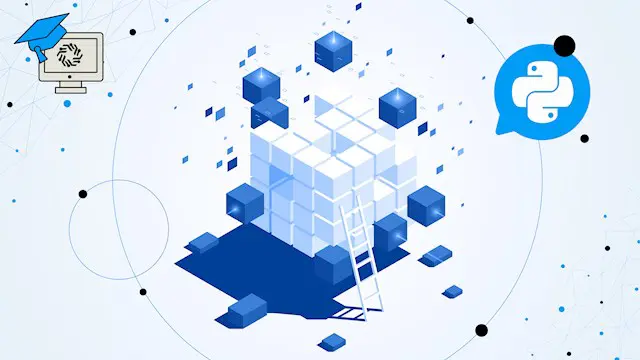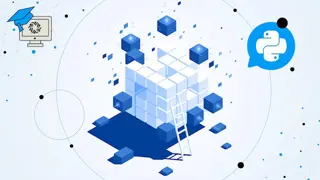
Python for Data Science & Machine Learning from A-Z
Lunes Online Learning
Become a professional Data Scientist and learn how to use NumPy, Pandas, Machine Learning and more!
Add to basket or enquire
Overview
Certificates
Reed courses certificate of completion
Digital certificate - Included
Will be downloadable when all lectures have been completed
Curriculum
-
Introduction 1:11:59
-
Data Science & Machine Learning Concepts 1:06:38
-
Python for Data Science 3:53:21
-
Statistics for Data Science 1:08:09
-
Probability and Hypothesis Testing 20:48
-
NumPy Data Analysis 52:33
-
Pandas Data Analysis 33:58
-
Python Data Visualization 46:05
-
Machine Learning 26:03
-
Data Loading & Exploration 13:06
-
Data Cleaning 15:24
-
Feature Selecting & Engineering 06:11
-
Linear & Logistic Regression 49:19
-
K Nearest Neighbors 1:36:48
-
Decision Trees 2:51:13
-
Ensemble Learning & Random Forests 1:44:06
-
Support Vector Machines 1:41:56
-
K-means 1:00:16
-
PCA 2:00:20
-
Data Science Career 35:10
-
Course Resources 20:33:00
Course media
Description
Learn Python for Data Science & Machine Learning from A-Z
In this practical, hands-on course you’ll learn how to program using Python for Data Science and Machine Learning. This includes data analysis, visualization, and how to make use of that data in a practical manner.
Our main objective is to give you the education not just to understand the ins and outs of the Python programming language for Data Science and Machine Learning, but also to learn exactly how to become a professional Data Scientist with Python and land your first job.
We'll go over some of the best and most important Python libraries for data science such as NumPy, Pandas, and Matplotlib +
-
NumPy — A library that makes a variety of mathematical and statistical operations easier; it is also the basis for many features of the pandas library.
-
Pandas — A Python library created specifically to facilitate working with data, this is the bread and butter of a lot of Python data science work.
NumPy and Pandas are great for exploring and playing with data. Matplotlib is a data visualization library that makes graphs as you’d find in Excel or Google Sheets. Blending practical work with solid theoretical training, we take you from the basics of Python Programming for Data Science to mastery.
This Machine Learning with Python course dives into the basics of machine learning using Python. You'll learn about supervised vs. unsupervised learning, look into how statistical modeling relates to machine learning, and do a comparison of each.
We understand that theory is important to build a solid foundation, we understand that theory alone isn’t going to get the job done so that’s why this course is packed with practical hands-on examples that you can follow step by step. Even if you already have some coding experience, or want to learn about the advanced features of the Python programming language, this course is for you!
Python coding experience is either required or recommended in job postings for data scientists, machine learning engineers, big data engineers, IT specialists, database developers, and much more. Adding Python coding language skills to your resume will help you in any one of these data specializations requiring mastery of statistical techniques.
Together we’re going to give you the foundational education that you need to know not just on how to write code in Python, analyze and visualize data and utilize machine learning algorithms but also how to get paid for your newly developed programming skills.
The course covers 5 main areas:
1: PYTHON FOR DS+ML COURSE INTRO
This intro section gives you a full introduction to the Python for Data Science and Machine Learning course, data science industry, and marketplace, job opportunities and salaries, and the various data science job roles.
-
Intro to Data Science + Machine Learning with Python
-
Data Science Industry and Marketplace
-
Data Science Job Opportunities
-
How To Get a Data Science Job
-
Machine Learning Concepts & Algorithms
2: PYTHON DATA ANALYSIS/VISUALIZATION
This section gives you a full introduction to the Data Analysis and Data Visualization with Python with hands-on step by step training.
-
Python Crash Course
-
NumPy Data Analysis
-
Pandas Data Analysis
3: MATHEMATICS FOR DATA SCIENCE
This section gives you a full introduction to the mathematics for data science such as statistics and probability.
-
Descriptive Statistics
-
Measure of Variability
-
Inferential Statistics
-
Probability
-
Hypothesis Testing
4: MACHINE LEARNING
This section gives you a full introduction to Machine Learning including Supervised & Unsupervised ML with hands-on step-by-step training.
-
Intro to Machine Learning
-
Data Preprocessing
-
Linear Regression
-
Logistic Regression
-
K-Nearest Neighbors
-
Decision Trees
-
Ensemble Learning
-
Support Vector Machines
-
K-Means Clustering
-
PCA
5: STARTING A DATA SCIENCE CAREER
This section gives you a full introduction to starting a career as a Data Scientist with hands-on step by step training.
-
Creating a Resume
-
Creating a Cover Letter
-
Personal Branding
-
Freelancing + Freelance websites
-
Importance of Having a Website
-
Networking
By the end of the course you’ll be a professional Data Scientist with Python and confidently apply for jobs and feel good knowing that you have the skills and knowledge to back it up.
Who is this course for?
- Students who want to learn about Python for Data Science & Machine Learning
Requirements
-
Students should have basic computer skills
-
Students would benefit from having prior Python Experience but not necessary
Questions and answers
I have very basic computer skills. Will i be able to do this course. And is it beneficial for a person over the age of 60 years.?
Answer:Hi Khalid, yes this course goes over the basic fundamentals of python and then python for data science. No matter the age, you'll be able to learn new skills.
This was helpful.
Reviews
Sidebar navigation
Legal information
This course is advertised on Reed.co.uk by the Course Provider, whose terms and conditions apply. Purchases are made directly from the Course Provider, and as such, content and materials are supplied by the Course Provider directly. Reed is acting as agent and not reseller in relation to this course. Reed's only responsibility is to facilitate your payment for the course. It is your responsibility to review and agree to the Course Provider's terms and conditions and satisfy yourself as to the suitability of the course you intend to purchase. Reed will not have any responsibility for the content of the course and/or associated materials.


